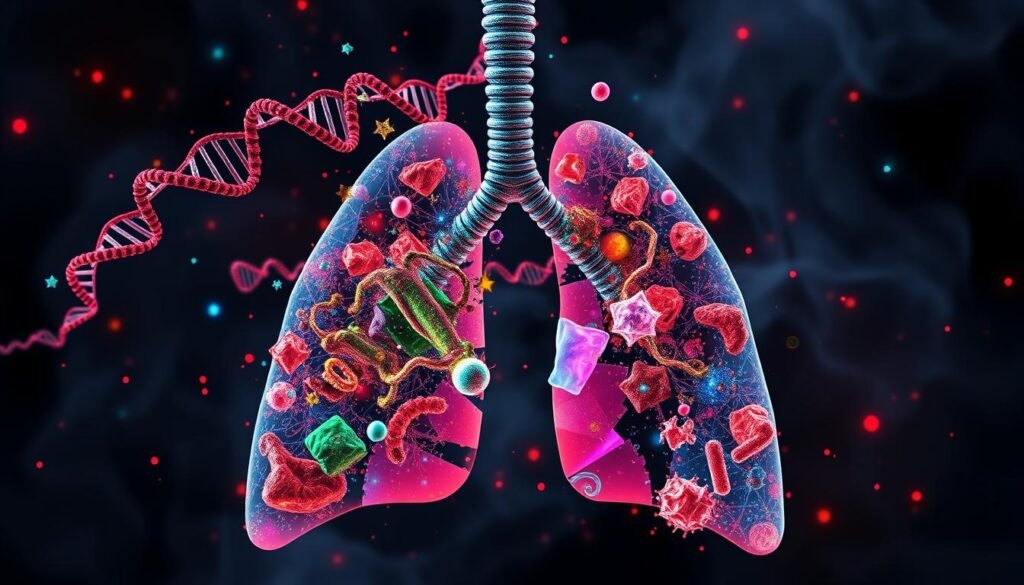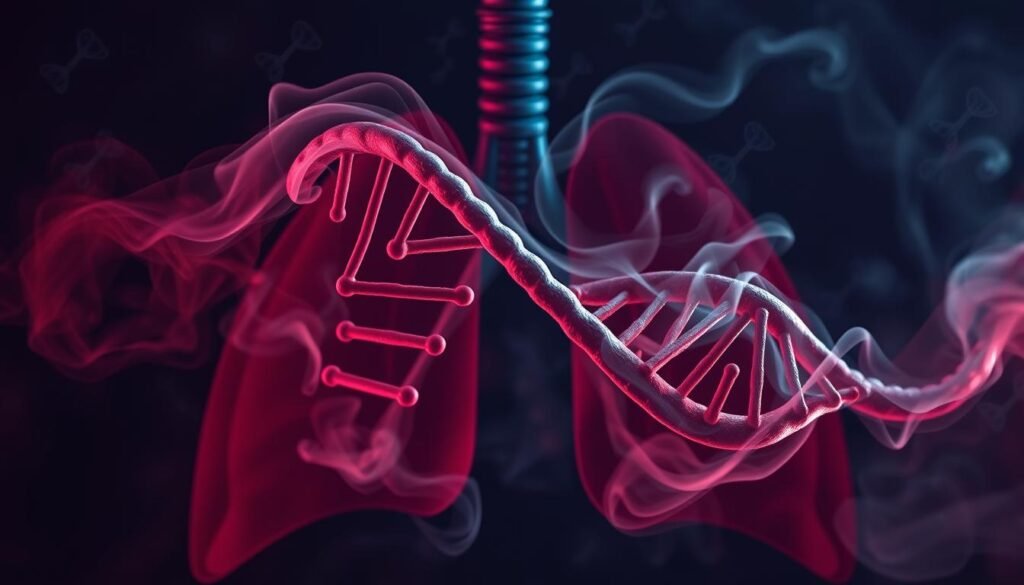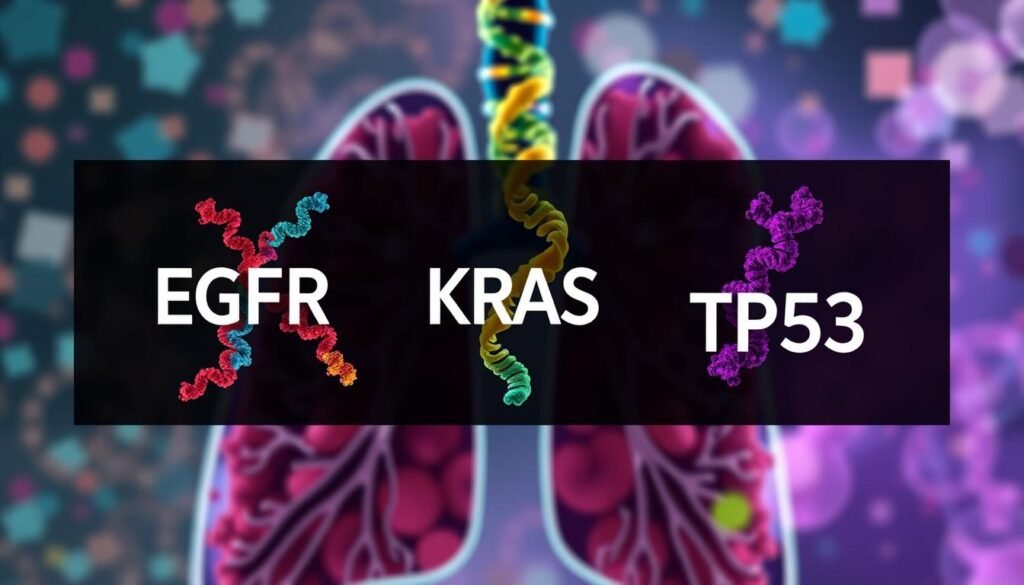Did you know that around 6.6% of people will get lung cancer in their lives? This disease is more complex than many think. It is mainly caused by environmental factors, but genes also play a part. Though smoking is behind about 85% of lung cancer in the U.S., genes can make some more likely to get this tough disease.
Knowing how genes affect lung cancer risk is key for early detection and prevention. Research shows most lung cancer cases aren’t due to inherited genetic changes. However, a small number may be passed down in families. This makes genetic counseling very important for those with lung cancer in their family history.
The risk of lung cancer is influenced by both genetics and lifestyle, like smoking or being around harmful substances. This points out the importance of being aware of genetic risks. It also stresses the need for families to talk about health issues. For deeper insights on how genetics play into lung cancer, you can check out this resource.
Key Takeaways
- Lung cancer affects approximately 222,500 individuals annually in the U.S.
- Only about 10%–15% of all smokers develop lung cancer.
- Genetic predisposition plays a role in a small percentage of lung cancer cases.
- Environmental factors, especially smoking, increase lung cancer risk significantly.
- Genetic counseling can help families understand their risks.
- Understanding the link between inherited genes and lung cancer is essential for prevention.
Understanding Lung Cancer
Lung cancer is a major health issue caused by uncontrolled cell growth in the lungs. There are two main kinds: small cell lung cancer and non-small cell lung cancer. Knowing the difference between them is key for correct diagnosis and treatment.
Definition and Types of Lung Cancer
Small cell lung cancer (SCLC) spreads quickly and usually has a worse outlook. Non-small cell lung cancer (NSCLC) is more common and includes types like adenocarcinoma and squamous cell carcinoma. The way these cancers grow and respond to treatment affects how a patient recovers.
Common Symptoms and Signs
It’s important to know the symptoms of lung cancer for early detection. Common signs include:
- Persistent coughing
- Chest pain
- Unexplained weight loss
- Shortness of breath
- Spitting up blood
Often, lung cancer doesn’t show symptoms in early stages, which makes diagnosing it hard. Knowing these signs is crucial for getting help early on.
| Type of Lung Cancer | Characteristics | Growth Rate | Treatment Options |
|---|---|---|---|
| Small Cell Lung Cancer (SCLC) | Aggressive, often metastasizes quickly | Fast | Chemotherapy, Radiation |
| Non-Small Cell Lung Cancer (NSCLC) | More common, includes several subtypes | Slower | Surgery, Chemotherapy, Targeted Therapy |
Prevalence of Lung Cancer in the United States
Lung cancer is the second most common cancer in the U.S., hitting men and women alike. It’s key to know the numbers to understand its effect on health. Around 234,580 new cases are expected in 2024, showing it’s a major concern.
Statistics and Survival Rates
The five-year survival rate for lung cancer is quite low, at only about 15%. This fact underscores the need for early spotting and treatment. Most lung cancer cases, about 80% to 85%, are non-small cell lung cancer (NSCLC). Race and ethnicity play a role in these numbers too.
Risk Factors Associated with Lung Cancer
Several factors can raise one’s risk of getting lung cancer. Main factors include:
- Smoking: The top cause, as it’s behind many lung cancer cases.
- Radon Exposure: This gas can build up in homes, raising the risk.
- Environmental Pollutants: Harmful air substances also up the risk.
- Family History: If close family members had it, your risk goes up.
Studies show genetic differences affect NSCLC risk and how long people live after getting it. For example, African Americans are more affected by lung cancer than Caucasians and Hispanics. It’s vital to look at lung cancer risk factors in different groups.
The Role of Genes in Lung Cancer Development
Genetic changes play a big role in lung cancer. Both somatic and germline mutations contribute to the disease’s risk. Knowing how these changes affect cell growth helps us understand cancer’s origins.
Genetic Mutations and Their Impact on Cell Growth
Genes control cell growth, but mutations can upset this balance. The EGFR gene mutation, for instance, shows up in many lung cancer cases. It’s common among nonsmokers and women in East Asia. The KRAS gene mutation is also prominent in lung cancer.
Other important genes include MET, LKB1, BRAF, PIK3CA, ALK, RET, and ROS1. These mutations can cause cells to grow out of control, leading to tumors.
Somatic vs. Germline Mutations
Somatic mutations are not inherited. They happen in a person’s lifetime due to environmental factors. These changes can affect how cells grow.
Germline mutations are passed down from parents and can predispose someone to lung cancer. About 8% of lung cancer cases are due to genetics. In families with lung cancer history, certain mutations increase cancer risk.
Only 1% of lung cancer cases involve inherited mutations. However, their impact is significant. If one parent has a germline mutation, their child might inherit it. This could greatly increase their lung cancer risk.

Inherited Genes and Lung Cancer
Lung cancer can be complex, especially when looking at inherited genes. A few lung cancer cases are due to hereditary factors, even though most come from environmental sources. This shows why it’s crucial to understand the genetic part of the risk. Family members with lung cancer often share genes and environmental risks. This mix increases their chance of getting the disease.
Understanding Genetic Predisposition
An increased likelihood of getting lung cancer due to inherited genes is called genetic predisposition. Some genetic changes, like specific ones in the EGFR gene, can raise lung cancer risk. Young people with lung adenocarcinomas might face a higher risk if they have Li-Fraumeni syndrome. This condition involves harmful changes in the TP53 gene. It shows how inherited factors can influence cancer risk.
Familial Cancer Syndromes and Their Implications
Conditions like Li-Fraumeni syndrome provide insights into familial cancer syndromes. People with these syndromes need careful monitoring and prevention efforts. Knowing about genetic risks helps those at high risk to seek early detection. Genetic testing can spot these risks. It helps doctors and families choose the best prevention and screening steps.

Common Gene Mutations Linked to Lung Cancer
Looking into gene mutations that cause lung cancer helps us create better treatments. Mutations like EGFR, KRAS, and TP53 are really important in how lung cancer grows. Each mutation affects patients differently.
EGFR Mutations in Lung Cancer Patients
About 10-15% of non-small cell lung cancer (NSCLC) patients have EGFR mutations. They’re often found in women, people who never smoked, and those with a certain type of NSCLC. Finding EGFR mutations lets doctors use special treatments, which helps patients live longer.
K-RAS and TP53 Gene Mutations
KRAS mutations are found in roughly 25% of people with lung cancer, especially in those with adenocarcinoma. This mutation usually means the cancer might get worse faster. Then there’s TP53 mutations, which mess up how cells normally work, letting tumors grow.

Environmental Influences on Genetic Expression
It’s vital to understand how our environment affects genetic expression, especially for lung cancer risk. Smoking, air pollution, and exposure to harmful substances majorly contribute to lung cancer. These external factors interact with our genetics. This interaction could increase someone’s chance of getting lung cancer. For example, certain genes may make you more likely to get cancer if you’re around carcinogens. This shows how important our lifestyle choices are.
Gene-Environment Interactions
The link between our genetics and our environment shows how certain lifestyle choices can change our health. Studies show that environmental factors can change how genes related to lung cancer work. To understand these changes, researchers study how outside factors might activate or reduce genetic risks. Changes in our diet or the environment can lead to mutations that cause lung cancer. It’s important to look at these factors when thinking about how to prevent this disease.
Impact of Lifestyle Factors on Lung Cancer Risk
Lifestyle choices are key in figuring out someone’s risk for lung cancer. Smoking, for instance, introduces harmful substances into our bodies. This can worsen any genetic risks we might have. Also, people with fewer allergies might have a higher risk of lung cancer. It’s important to understand how our immune system and genetics work together in this. Researchers are looking into how these aspects affect our lung health. For more details, visit the NCBI page on gene-environment interactions.
| Environmental Influence | Impact on Genetic Expression |
|---|---|
| Smoking | Induces somatic mutations, contributing to tumorigenesis. |
| Air Pollution | Alters gene methylation patterns linked to cancer susceptibility. |
| Dietary Habits | Modulates gene expression related to inflammation and cell growth. |
| Allergies | Potentially influence immune responses and lung health. |
| Radon Exposure | Increases risk of lung cancer through genetic damage. |
In summary, environmental factors and genetics together shape our lung cancer risk. More research is needed to find better prevention and treatment methods. Knowing these factors helps us make choices that could lower our cancer risk.
Genetic Testing for Lung Cancer Risk
Understanding genetic testing is key for people at risk of lung cancer. It finds gene changes that may increase lung cancer risk, especially if lung cancer runs in the family.
Importance of Genetic Testing for At-Risk Individuals
Genetic testing gives important insights to those at risk for lung cancer. It can uncover a genetic tendency toward the disease. This helps in early intervention, making lung cancer screening more effective. Often, tests look for changes in genes linked to a type of lung cancer called non-small cell lung cancer (NSCLC). Knowing about these gene changes helps doctors suggest specific treatments that can work well.
Current Recommendations and Screening Guidelines
Experts recommend lung cancer screening for those 50 to 80 years old who smoked a lot. Catching cancer early is key to better treatment results. Genetic testing adds to these guidelines by using gene test results. This lets doctors tailor screening and treatment for each patient’s genetic makeup. For more on genetic testing, see current resources available.
Research and Advancements in Cancer Genomics
The treatment of lung cancer is changing fast, thanks to big steps forward in cancer genomics. We’re learning a lot about how certain genetic changes cause lung cancer to grow and spread. This knowledge is leading to better, more personalized ways to treat lung cancer. Now, doctors can use targeted therapies to fight the disease.
Recent Discoveries in Lung Cancer Genetics
In the last eight years, new tools like next-generation sequencing (NGS) have changed cancer research. With NGS, scientists can study many cancer types, including lung cancer, in detail. They find out about changes in DNA that could cause cancer. This includes mutations, changes in the number of DNA copies, and rearrangements in tumor DNA. Knowing about these changes can help find the best treatment for each patient.
The Future of Targeted Therapies
Future treatments for lung cancer look promising thanks to research. Techniques that look at all of a cancer’s genes are developing. But these methods can be expensive and take time. To get around this, many labs test smaller sets of genes. This is quicker and helps find mutations that treatments can target. It means even in complex cancers, we can spot important mutations to treat.
Conclusion
The connection between genes and lung cancer is complex. It involves both genetics and environmental factors. Specific gene mutations, like those on chromosome 15, increase lung cancer risk in smokers. This mutation raises their susceptibility by 30% to 80%, making their overall risk about 20% to 23%. These discoveries highlight why knowing about genetics is key in lung cancer prevention.
Research has found over 100 genetic regions linked to lung cancer. These findings come from genome-wide association studies (GWAS). Single nucleotide polymorphisms (SNPs) are among these and are tied to a higher lung cancer risk. They show that lung cancer risk is not just about smoking. It’s also about our inherited genes. This suggests some lung cancers may run in families due to these genetic changes.
Advancements in research are improving our understanding of lung cancer genetics. Mutations in genes like BRCA2 and CHEK2 matter in lung cancer, affecting outcomes. By exploring the genetic sides of lung cancer, doctors can better assess risks. This helps in developing personalized treatments. By doing so, we’re getting closer to a more efficient way to fight this illness.